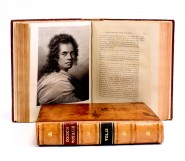Lot #28 - Guy Grey-Smith
-
Auction House:Deutscher and Hackett
-
Sale Name:Important Australian + International Fine Art including significant works from The Collection of Joan and Peter Clemenger & The Krongold Collection
-
Sale Date:16 Aug 2023 ~ 7pm (AEST)
-
Lot #:28
-
Lot Description:Guy Grey-Smith
(1916 - 1981)
Seascape, 1972
oil and beeswax emulsion on muslin on composition board
99.0 x 122.0 cm
signed and dated lower right: G. Grey-Smith / 72 inscribed verso: 3 GUY GREY-SMITH 'SEASCAPE' -
Provenance:Old Fire Station Gallery, Perth Private collection, Western Australia, acquired in the mid 1970s
-
Exhibited:Guy Grey-Smith, Macquarie Galleries, Sydney, 12-24 July 1972, cat. 2 G. Grey-Smith, Old Fire Station Gallery, Perth, 21 October - 7 November 1973, cat. 3 Five Festival Artists of the Adelaide Festival of Arts , Greenhill Galleries, Adelaide, 9 March ? April 1974 (label attached verso)
-
References:Gaynor, A., Guy Grey-Smith: Life Force , University of Western Australia Publishing, Perth, 2012, pp. 262, 263
-
Notes:By the early 1970s, Guy Grey-Smith was one of Western Australia's most travelled artists, having journeyed through much of Europe - including Belgium, Poland and Germany as a POW - and had become in many ways a pioneer of the interaction between Australian and Asian artists through focussed visits in the 1960s to Sri Lanka (then Ceylon), Bali and Cambodia. Already renowned for his arresting, high-colour images utilising paint thickened by a home-made beeswax emulsion and applied with scrapers, the Asian encounters led Grey-Smith to seek ways to go beyond his known style and explore other possibilities. Balinese art in particular had a great impact on the artist and upon his return to Australia, he re-introduced the brush to his paintings, as well as curlicues and arcs inspired by the ornate Hindu temple carvings for which the island is famed. Above the sea, 1968 (Curtin University, Perth) was his first major breakthrough, a shimmering view of the ocean from the air. Thus primed, Grey-Smith and his artist-wife Helen, set off to take up the post of Professor of Fine Art at Phnom Penh University in the second half of 1969. During the first six months of their stay, Guy taught western painting techniques (whilst a Soviet instructor taught Social Realist painting in the next room) and Helen taught textiles. In their free time, they explored many ancient sites including the Bayon (Prasat Bayoăn) and Angkor Wat attending numerous dances and celebrations in the process. A powerful suite of paintings from this period emerged, following on from direction signalled by Above the sea , but now with greater chromatic intensity and fluency in the brush marks. These include: Neak Pean Angkor 1969; Angkor Wat , 1970; and Cambodian monkey dance , 1970, all now in significant private collections. However, in March 1970, disaster struck. A CIA-backed coup erupted and hostilities began against the North Vietnamese. The Grey-Smiths watched in horror as their students left to take up arms - 'like lambs to the slaughter' 1 - and all of Guy's World War Two trauma returned, leading to a major nervous breakdown. It took a harrowing number of weeks before they could be repatriated and Grey-Smith returned a broken man. Understandably, art was to be his major salvation and he spent the next eighteen months experimenting with acrylic paint with mixed results; but by 1972, he was once again in control and the resultant works became stronger, more optimistic and vital, with Seascape , 1972, being a perfect example. The exact location for Seascape is unknown, but Grey-Smith spent recuperative time during 1971 at the family's self-built beach house at Quinns Rocks, north of Perth, and travelled up further through the Murchison and Ashburton districts. There is a brooding sensuality in Seascape , with the rich indigo and ultramarine countered by the lighter tones of the shore-break. The smooth lines of the rounded hills are picked out in yellow and orange, and the tension of the design is accentuated by the contrast of the major areas applied with paint scraper set against the curved delineations done with the brush. Although shown in an exhibition during the Adelaide Festival of Arts in 1974, it appears that Seascape then returned to Perth where it was subsequently purchased from Rie Heyman's Old Fire Station Gallery in Subiaco. 1. Interview with Guy Grey-Smith , Western Australian Stories on the Arts, ABC program number PWN5179. Date of transmission: 1970. ANDREW GAYNOR
-
Estimate:A$30,000 - 40,000
-
Realised Price:
-
Category:Art
This Sale has been held and this item is no longer available. Details are provided for information purposes only.










